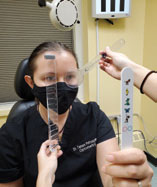

If you experience any of the symptoms listed above, contact an eye doctor near you that may be able to help diagnose and discuss treatment options for BVD. Agoraphobia, dislike of open or unfamiliar areas.Loses confidence in accurately judging distances.Difficulties driving at night or in low light.Difficulties with body-hand-eye coordination.Poor stereo vision or judging distances.Words seem to ‘float’ or merge together.

Reduced comprehension or reading fluency.Dim lighting blurry, eg restaurant menu or theatre.Reading or computer are difficult to see clearly.Knocks into shelves when walking down the aisle.Moves over to left or right side when walking.Aches in neck and/or shoulder and back pain.The following symptoms are experienced by many BVD patients Physical Findings: Eye doctors sometimes categorized them to make it a bit easier to understand. The list of symptoms of BVD can feel endless. Doing basic tasks, such as driving a car or reading, can become difficult, due to motion sickness and results in life-changing anxiety and disorientation.īVD can severely negatively impact the quality of life. Symptoms of BVDīVD symptoms can interfere with a person’s ability to function on a day-to-day basis.

Binocular Vision Dysfunction (BVD) is a condition where the eyes are slightly misaligned and the eyes struggle to send one clear image to the brain.īVD can cause a variety of symptoms such as dizziness, motion sickness, headache, and light sensitivity.īVD can significantly impact the lives of both children and adults and since there is a wide range of symptoms to BVD, this condition is often misdiagnosed as dyslexia or ADD/ADHD.


 0 kommentar(er)
0 kommentar(er)
